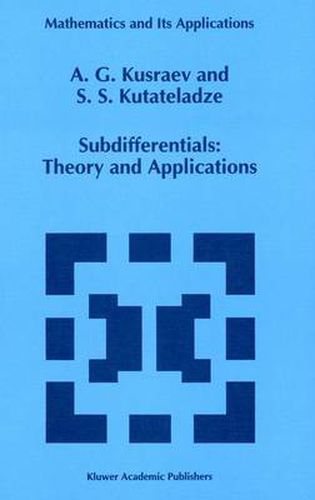Readings Newsletter
Become a Readings Member to make your shopping experience even easier.
Sign in or sign up for free!
You’re not far away from qualifying for FREE standard shipping within Australia
You’ve qualified for FREE standard shipping within Australia
The cart is loading…






This title is printed to order. This book may have been self-published. If so, we cannot guarantee the quality of the content. In the main most books will have gone through the editing process however some may not. We therefore suggest that you be aware of this before ordering this book. If in doubt check either the author or publisher’s details as we are unable to accept any returns unless they are faulty. Please contact us if you have any questions.
The subject of the present book is sub differential calculus. The main source of this branch of functional analysis is the theory of extremal problems. For a start, we explicate the origin and statement of the principal problems of sub differential calculus. To this end, consider an abstract minimization problem formulated as follows: x E X, f(x) –+ inf. Here X is a vector space and f : X –+ iR is a numeric function taking possibly infinite values. In these circumstances, we are usually interested in the quantity inf f( x), the value of the problem, and in a solution or an optimum plan of the problem (i. e. , such an x that f(x) = inf f(X , if the latter exists. It is a rare occurrence to solve an arbitrary problem explicitly, i. e. to exhibit the value of the problem and one of its solutions. In this respect it becomes necessary to simplify the initial problem by reducing it to somewhat more manageable modifications formulated with the details of the structure of the objective function taken in due account. The conventional hypothesis presumed in attempts at theoretically approaching the reduction sought is as follows. Introducing an auxiliary function 1, one considers the next problem: x EX, f(x) -l(x) –+ inf. Furthermore, the new problem is assumed to be as complicated as the initial prob lem provided that 1 is a linear functional over X, i. e.
$9.00 standard shipping within Australia
FREE standard shipping within Australia for orders over $100.00
Express & International shipping calculated at checkout
This title is printed to order. This book may have been self-published. If so, we cannot guarantee the quality of the content. In the main most books will have gone through the editing process however some may not. We therefore suggest that you be aware of this before ordering this book. If in doubt check either the author or publisher’s details as we are unable to accept any returns unless they are faulty. Please contact us if you have any questions.
The subject of the present book is sub differential calculus. The main source of this branch of functional analysis is the theory of extremal problems. For a start, we explicate the origin and statement of the principal problems of sub differential calculus. To this end, consider an abstract minimization problem formulated as follows: x E X, f(x) –+ inf. Here X is a vector space and f : X –+ iR is a numeric function taking possibly infinite values. In these circumstances, we are usually interested in the quantity inf f( x), the value of the problem, and in a solution or an optimum plan of the problem (i. e. , such an x that f(x) = inf f(X , if the latter exists. It is a rare occurrence to solve an arbitrary problem explicitly, i. e. to exhibit the value of the problem and one of its solutions. In this respect it becomes necessary to simplify the initial problem by reducing it to somewhat more manageable modifications formulated with the details of the structure of the objective function taken in due account. The conventional hypothesis presumed in attempts at theoretically approaching the reduction sought is as follows. Introducing an auxiliary function 1, one considers the next problem: x EX, f(x) -l(x) –+ inf. Furthermore, the new problem is assumed to be as complicated as the initial prob lem provided that 1 is a linear functional over X, i. e.